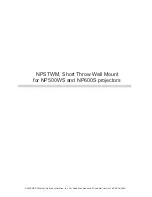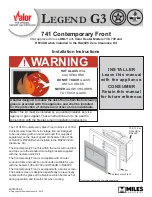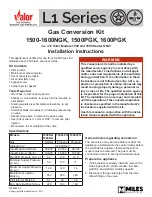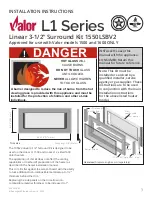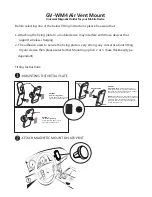
1. Basic Inroduction
Product User Manual
5
6
3) For the automotive module or portable module application, appropriate measures
of shock absorbing shall be taken.
4) Leave enough adequate space above the battery module inner the battery box ,to
connect the battery management system harness line, also for better heat
dissipation.
5) When batteries are integrated into group, insulated protective measures shall be
taken;
6) When the communication system is installed, it should be checked whether the
feeder line connected to the grid is flow in advance, including each node, the
socket connection, in order to avoid the open or short circuit faults.
2.5 Battery Connection Requirements
Electrical connection should comply with the relevant national electrical installation
practices.
1) Be careful when connecting the batteries, do pay attention to safety of high
voltage to avoid battery short circuit;
2) Quick connectors shall be set between battery modules, higher protectionlevel of
power cord, plug and socket connectors and charging plugs and sockets shall be
chose.
3) When connecting the battery management system with batteries, copper and
aluminum terminal surface of the battery shall be sanded (180 to 240 mesh is
recommended for sanding, nickel terminal pole is prohibited to sand) to remove
the oxide layer, thus reducing the contact resistance. If the copper bus bar surface
is not processed, the contact surface of bus bar and connectors should be
polished.
4) Battery pole bolts must be tightened so as to avoid increasing contact resistance
caused by poor contact. As the positive pole of battery is made by aluminum
material, avoid excessive force when tightening the pole bolt to avoid screw
thread slipping. For tightening torque
,
please refer to content 2.6;
5) Make sure the welding and crimping of BMS acquisition line for voltage terminals,
and connection of wiring harness reliable, avoid affecting voltage signal sampling
accuracy due to poor contact. Insulating bush covering the terminals should not
be too long so as to wrap the terminals.
6) The voltage acquisition line length should be appropriate. If the voltage acquisition
line is too long, voltage on it will drop excessively
,
which can bring large error for
voltage measurement.
Battery terminal pole sanding
Bus bar sanding
2.6 Operation tools
1) During the process of battery connection, insulating gloves must be worn.
2) The socket wrench, fixed wrench and screwdriver and other tools used for opera-
tion must be gone through rigorously insulating treatment. The operators are
prohibited to carry metal items such as key chains, watches, necklaces and so on;
3) When the terminal voltage of the connected grouping products is greater than
24V, insulating gloves which can withstand voltage higher than the voltage of the
entire group of connected systems shall be worn.
4) When tightening the bolts, it is recommend using adjustable torque wrench in
5-30N•m range, the recommended tightening torque values corresponding to
specified bolts is shown in the following table.
2.7 Power system maintenance period and measures
1) In a routine systematic check and detailed record on the power system usage, as well as the work of BMS and charger, detect
hidden dangers and solve problems in time.
2) Regularly check the connecting bolts fuses, contactors and fuses, as well as the degree of tightening for all the bolts connecting
the battery poles.
3) Regular inspect the connection reliability of all power connectors and electrical connectors, and check the insulation of the
electric circuit and connection of cables and busbars.
4) Check the battery voltage and current differences between BMS detected and data actually measured, and check BMS signal
acquisition accuracy and check whether the SOC calculation precision calibration is required;
5) Check the consistency of the whole set of batteries. If static or dynamic voltage difference of the battery is too large, please
operate as troubleshooting steps.
2.8 Common troubleshooting methods for power system
Tools insulating treatment
Insulating gloves
No.
1
2
3
4
Terminal bolt specification
M5
M6
M8
M14
recommended tightening torque
(
N·m
)
10
9
14
24
Note: Data shown on the table are manual measurement experience; If you
purchase by yourselves, we recommend bolt material A2-70; Tightening
torque can be referred to the recommended values corresponding to the
thread diameter above.
No.
1
2
3
4
5
Common Fault
Failure Cause
Approach
Note: 1. The examination and treatment for the power system should be based on system technology agreement;
2. The examination for the power system requires trained personnel, and pay attention to the safety protection against high
voltage and devices wounding during examination ;
3 .If they can not determine the cause of failure, contact our after-sales personnel promptly.
Voltage acquisition failure (BMS software problems, poor
socket contact, acquisition line connection error, loose
connections of battery terminals, etc.)
Temperature acquisition abnormal
(
acquisition device
damage, bad connectors, pole connections loose)
Thermal management system abnormal (fan or heating
device does not start, duct blockage, etc.)
Battery itself reason(terminal severe oxidation, internal
reasons)
Abuse like over charge, over discharge; environmental
reasons like high temperature, high humidity, ultra low
pressure
upside down and other external cause
tightening torque is too large, tightening operation not
standard
Battery fault
(
State of charge is inconsistent, internal
reasons
)
Abnormal voltage
Abnormal temperature
Battery bulging
Battery leakage
Terminal slippery
1. Investigating the fault and eliminated;
2. If the fault does not exist, it may be
the batteries fault.
Investigation of the cause of the fault
and eliminate
Check the thermal management system
repair or replace
Troubleshooting and contact after sales
Troubleshooting and contact after sales
Troubleshooting and replace
repair or replace












